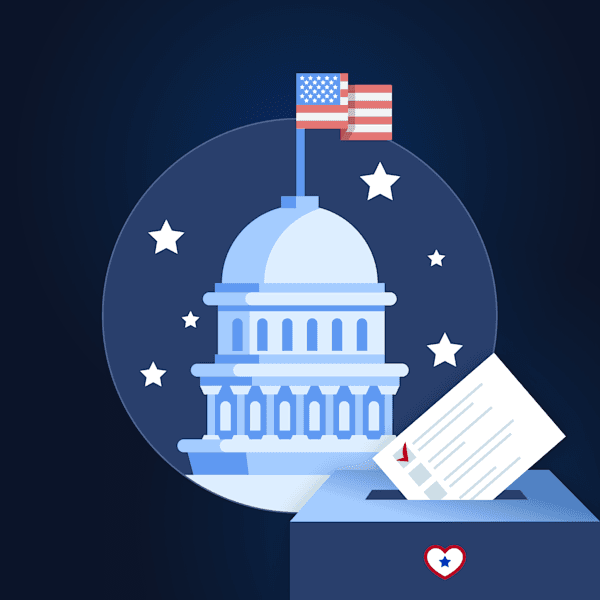
The Pros and Cons of Publicly Funded Elections
If there’s one thing that voters can agree on these days, it’s that the money spent on elections could be better spent elsewhere. The amounts for the upcoming elections are already staggering, and we’re not even into 2024 yet.
As we head into the heat of the 2023-2024 election cycle:
Candidates for various House and Senate seats have reported a combined total of $556.9 million dollars in campaign funding so far
State, national, and local political committees raked in a total of $348.8 million in federal election funds
By the first half of 2023, 7,283 registered federal PACs reported total receipts of $1.6 billion dollars.
As dizzying as these numbers are, they’re nothing compared to the swirl of dark money that ensnares politicians and makes them more likely to answer to special interests.
One of the easiest solutions to the problem of campaign finance and its influence on elections is to publicly fund them.
Understanding Publicly Funded Elections
Publicly funded elections are a system of electoral financing where government funds are used to support the campaigns of political candidates or parties. This contrasts with our current campaign finance system that’s primarily privately funded, which forces candidates to rely on donations from individuals, corporations, or political action committees.
The idea behind public funding is to level the playing field, reduce corruption, and limit the influence of wealthy donors in politics. Read on as we explore how publicly funded elections work, where they’re implemented, and how they help reduce political corruption.
Advantages and Drawbacks of Publicly Funding Elections
With any political activity, there are advantages and disadvantages. This is especially true when it comes to political finance, given the amount of money and influence at stake.
Pros of Publicly Funded Elections
Reduces Corruption: Public election funding limits the potential for corruption by reducing the reliance on large private donations.
Levels the Playing Field: Publicly funding elections helps smaller or new political parties compete more fairly against established parties.
Enhances Focus on Policy: When campaigns are publicly funded, candidates can focus more on policy and voter engagement rather than fundraising.
Adds to Political Diversity: Public campaign funding encourages a wider range of candidates to run for office, especially those without wealthy connections.
Limits the Influence of Special Interests: Public election funding diminishes the power of special interest groups in the political process.
Cons of Publicly Funded Elections
Cost to Taxpayers: The system is funded by taxpayers, and not everyone is inclined to agree with their money supporting certain political views.
Bureaucratic Complexity: Implementing and managing public funding can be complex and bureaucratic.
Potential for Abuse: Systems must be carefully designed to prevent misuse of public funds.
Limited Impact on Total Spending: Outside spending by independent groups may still dominate the political landscape.
Public Perception Issues: Some voters may view publicly funded campaigns as a misuse of government resources.
Public Election Funding in the United States
The Federal Election Commission (FEC) was created in 1971 as a part of the Federal Election Act that went into effect the following year. The goal was to mandate a mechanism for publicly funding elections and create an agency for overseeing compliance. However, the campaign funding mandate portion was struck down as unconstitutional a few years later by the Supreme Court in their decision on Buckley v. Valeo.
In essence, it made public funding an option and removed limits on expenditures except for presidential candidates who accept public funding.
Since that time, the amount of money available from private sources, especially organizations with deep pockets and vested interests, has made public funding a less desirable option. The 2010 Citizens United decision opened the floodgates to special interests.
However, public funding still exists.
Most people don’t realize that we have the opportunity to support public funding by donating $3 on our tax returns each year. The catch is that these funds are reserved for establishment candidates from one of the two major parties.
Either citizens don’t take advantage of this availability due to simple lack of awareness or a mistrust of government in general. However, when the people are the ones funding campaigns, candidates must answer to us.
We just need to find a way to make it a more attractive option to candidates with a real interest in serving the public instead of themselves.
Public campaign finance systems within the United States vary significantly across different states, with some adopting innovative approaches to encourage cleaner, more transparent elections. These systems mainly include clean election initiatives and matching funds.
Clean Election Initiatives
Maine: Maine's Clean Election Act, established in 1996, allows for the public financing of gubernatorial and legislative campaigns. Candidates who opt into this system must demonstrate a threshold level of support through small qualifying contributions and agree to strict spending and fundraising limits.
Arizona: Similar to Maine, Arizona implemented their Clean Elections Act in 1998. This act provides funding for state legislative and executive office campaigns. Candidates must collect a certain number of $5 contributions and agree to forgo private fundraising.
Connecticut: Connecticut’s Citizens' Election Program, established in 2005, provides public financing for both legislative and statewide offices. Candidates must raise a set number of small contributions to qualify and agree to spending caps.
Matching Funds Systems
New York City: One of the most notable local systems is New York City's matching funds program. It provides a 6-to-1 match for the first $175 of each contribution from city residents to qualifying candidates, encouraging candidates to seek smaller donations.
Los Angeles: Los Angeles offers a public matching funds program for city elections. It provides a 6-to-1 match for the first $114 of each contribution from city residents for primary elections and a 4-to-1 match for general elections.
Minneapolis: Minneapolis has a program that matches small individual contributions up to $175 for mayoral candidates and $100 for city council candidates, with certain limits. At the state level, Minnesota matches donations up to $50 at a 4-to-1 ratio for in-district donations and 2-to-1 for Minnesotans living outside of a district.
Variations Across Cities and States
Eligibility Requirements: States and cities have varying eligibility requirements for candidates to qualify for public funding, often based on demonstrating a certain level of grassroots support.
Spending and Contribution Limits: Most public financing programs require candidates to adhere to spending limits and sometimes contribution limits as a condition of receiving public funds.
Type of Offices Covered: While some states like Maine and Connecticut offer public financing for both legislative and statewide offices, others may limit it to certain offices.
Amount of Funds Available: The level of funding provided varies, with some places offering full funding for a campaign and others only partial support.
Matching Ratios: The ratio of public funds to private contributions varies, with some programs offering higher matching rates to encourage small donor participation.
State and local public campaign finance systems in the United States are diverse, reflecting the varied political and economic landscapes of the regions they serve. Clean election initiatives and matching funds programs are key strategies that are used to encourage candidates to focus on small donors and reduce the influence of large contributions.
These systems aim to enhance democratic participation, promote electoral competition, and build public trust in the political process. However, their effectiveness can be influenced by factors like legal challenges, political support, and the specific design of each program.
Countries with Publicly Funded Elections
Although public election funding has limited applications in the United States, other countries provide election funding to various degrees. Here are a few of the most notable:
Sweden: Provides direct financial support to political parties based on their election results. As such, major party candidates receive up to 90% of their funding from the state.
Germany: Matches small donations with public funds and provides grants based on party performance in elections. Donations from corporations are banned, but contributions from trade unions are not.
Japan: Offers a combination of direct public funding and strict limits on private donations that are regulated under the Political Fundraising Control Act.
United Kingdom: Focuses on short-term funding for election campaigns rather than ongoing party activities, which are covered by membership fees. Opposition parties receive public funding for administrative costs. There are also grants available for policy development.
Australia: In Australia, political candidates for state and national offices have public funding available. For national elections, candidates must garner support from at least 4% of the population to qualify.
As you can see, these systems reflect different priorities in balancing public support and private contributions.
The Impact on Big Money in Politics
One of the primary goals of publicly funded elections is to reduce the influence of big money in politics. In countries like Sweden and Germany, public funding has been relatively successful in creating a more balanced political environment.
However, the presence of outside spending and independent PACs, especially in systems like ours in the United States, can undermine these efforts. The key to success lies in the comprehensive design of the system, which must include limits on private donations and spending alongside public funding.
Publicly funded elections offer a compelling alternative to the traditional, privately-funded campaign model. By potentially reducing corruption and the influence of wealthy donors, these systems can make the democratic process more equitable and more focused on the needs of the electorate.
However, their success depends greatly on the specific design and implementation of each system, as well as the broader political and legal context in which they operate.
As the political landscape evolves, the conversation around publicly funded elections remains a critical part of the debate on how to create a more just and representative political system.
Real Change Begins Here
Reforming the political system in the United States is a huge undertaking. Fortunately, more Americans are waking up to the flaws inherent in our system, and they’re taking matters into their own hands through a growing independent movement.
GoodParty.org is proud to be a part of that movement, and we invite you to join us in our mission to break the two-party system and create a government that works for all of us.
Photo by Alexander Schimmeck on Unsplash

